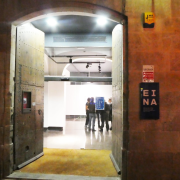During my recent trip to Barcelona in Spain, I took the opportunity to revisit some places associated with the year that I lived there (1993 to 1994). Back then, I did a postgraduate degree in painting there, through a UK art school that ran a satellite "study abroad" program in the 1990s. The school rented two buildings for the twenty or so artists: one in the heart of the Gothic Quarter, steps away from the Museo Picasso; and one in Poble Nou, a working class district on the eastern edge of the city.
The first photo above shows me in 2022 in front of the building in the Barra De Ferro, a narrow side street between Carrer de la Princesa and Carrer Montcada in the Gothic Quarter. The building accommodated an office for the course leader, a printmaking studio with press for the printmakers, and small partitioned studio spaces for artists. In common with most of the buildings in these narrow medieval streets, it was constructed with thick stone walls, a heavy wooden door, and large arched windows. The interior of the ground floor occupied by the art school had a ten foot high ceiling supported by solid stone arches.
I can remember going in and out of that building many times over the course of the year, meeting up with friends to see how their work was going, strolling with them along the street for lunch at one of the bars, or attending meetings with the course leader and talks by visiting artists. The ground floor seemed to be empty when I passed by in April, but I was pleased to discover that until recently it was still used as a printmaking centre by the EINA printmaking space. Here is the only photo I could find of the inside of the space:
My studio was in the Palo Alto building. In 1993, I was disappointed at first when I was allotted a space so far from the city centre (about thirty minutes door to door via the subway/metro). But when I saw the buildings and the location, I was pretty happy. Palo Alto is a set of former warehouses and small factories built in the early twentieth century for leatherworks and other light manufacturing. The former workshops and warehouses are surrounded by a wall that encloses them all in a small compound. The art school rented one of the smaller buildings, a two storey stone barn. Here is what it looked like in 1994 from the outside:


